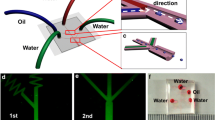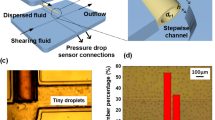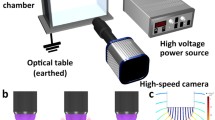Abstract
Microfluidic devices have been downscaled to dimensions of 10–1000 nm. Manipulation methods for femtoliter samples are important for realizing novel analytical devices. In the present study, we developed a microfluidic device that utilizes two-step flow focusing by air flows to generate femtoliter liquid droplets that float in the gas phase with size and trajectory control. The device includes a branched and stepped hydrophobic microchannel with four air inlets to exploit the instability of the gas–liquid interface. We succeeded in the generation of 704 fL (11.0 ± 0.01 μm) droplets of pure water and a shooting frequency of 24 kHz at a sample flow rate of 1 μL/min. In addition to pure water, we succeeded in generating acetonitrile droplets. The device operation was stable even at a sample flow rate of 101 pL/s, which is similar to that used in recent nanofluidic analytical devices. The results confirm that the instability of the gas–liquid interface is the dominant factor in femtoliter droplet generation as designed. Based on the experimental results, our method has a potential to generate droplets with the minimum volume of 123 fL (6.1 μm) in case of pure water, which can be achieved by minimizing the channel size. The present study provides a method based on gas–liquid micro/nanofluidics for the generation of uniform femtoliter droplets with trajectory control. This method is suitable for various applications, such as a size interface for the transport of femtoliter samples from nanofluidic devices to analytical instruments.










Similar content being viewed by others
References
Amstad E, Gopinadhan M, Holtze C, Osuji CO, Brenner MP, Spaepen F, Weitz DA (2015) Production of amorphous nanoparticles by supersonic spray-drying with a microfluidic nebulator. Science 349:956–960
Ben-Tzvi P, Rone W (2010) Microdroplet generation in gaseous and liquid environments. Microsyst Technol 16:333–356
Cubaud T, Mason TG (2008) Capillary threads and viscous droplets in square microchannels Phys. Fluids 20:053302
Dendukuri D, Doyle PS (2009) The synthesis and assembly of polymeric microparticles using microfluidics. Adv Mater 21:4071–4086
Duan C, Alibakhshi MA, Kim DK, Brown CM, Craik CS, Majumdar A (2016) Label-free electrical detection of enzymatic reactions in nanochannels. ACS Nano 10:7476–7484
Fraser RP, Eisenklam P, Dombrowski N, Hasson D (1962) Drop formation from rapidly moving liquid sheets. AIChE J 8:672–680
Günther A, Jensen KF (2006) Multiphase microfluidics: from flow characteristics to chemical and materials synthesis. Lab Chip 6:1487–1503
Herzenberg LA, Parks D, Sahaf B, Perez O, Roederer M, Herzenberg LA (2002) The history and future of the fluorescence activated cell sorter and flow cytometry: a view from Stanford. Clin Chem 48:1819–1827
Kazoe Y, Ugajin T, Ohta R, Mawatari K, Kitamori T (2019) Parallel multiphase nanofluidics utilizing nanochannels with partial hydrophobic surface modification and application to femtoliter solvent extraction. Lab Chip 19:3844–3852
Kazoe Y, Shimizu Y, Terui Y, Morikawa K, Mawatari K, Kitamori T (2021) Development of microfluidic droplet shooter and its application to interface for mass spectrometry. Sens Act b: Chemical 340:129957
Kebarle P, Verkerk UH (2009) Electrospray: from ions in solution to ions in the gas phase, what we know now. Mass Spectrom Rev 28:898–917
Kundu PK, Cohen IM (2004) Fluid mechanics. Elsevier Academic Press
Mawatari K, Kazoe Y, Aota A, Tsukahara T, Sato K, Kitamori T (2011) Microflow systems for chemical synthesis and analysis: approaches to full integration of chemical process. J Flow Chem 1:3–12
Mawatari K, Kazoe Y, Shimizu H, Pihosh Y, Kitamori T (2014) Extended-nanofluidics: Fundamental technologies, unique liquid properties, and application in chemical and bio analysis methods and devices. Anal Chem 86:4068–4077
Mesbah K, Thai R, Bregant S, Malloggi F (2017) DMF-MALDI: droplet based microfluidic combined to MALDI-TOF for focused peptide detection. Sci Reports 7:6756
Nakao T, Kazoe Y, Mori E, Morikawa K, Fukasawa T, Yoshizaki A, Kitamori T (2019) Cytokine analysis on a countable number of molecules from living single cells on nanofluidic devices. Analyst 144:7200–7208
Rafati AA, Bagheri A, Najafi M (2010) Experimental data and correlation of surface tensions of the binary and ternary systems of water + acetonitrile + 2-propanol at 298.15 K and atmospheric pressure. J Chem Eng Data 55:4039–4043
Rassaei L, Mathwig K, Kang S, Heering HA, Lemay SG (2014) Integrated biodetection in a nanofluidic device. ACS Nano 8:8278–8284
Shimizu H, Mawatari K, Kitamori T (2010) Sensitive determination of concentration of nonfluorescent species in an extended-nano channel by differential interference contrast thermal lens microscope. Anal Chem 82:7479–7484
Shirai K, Mawatari K, Kitamori T (2014) Extended nanofluidic immunochemical reaction with femtoliter sample volumes. Small 10:1514–1522
Stavis SM, Edel JB, Li Y, Samiee KT, Luo D, Craighead HG (2005) Detection and identification of nucleic acid engineered fluorescent labels in submicrometre fluidic channels. Nanotechnology 76:S314–S323
Tanaka N, Kinoshita H, Araki M, Tsuda T (1985) On-column preparation of chemically bonded stationary phase with maximum surface coverage and high reproducibility, and its application topacked microcapillary columns. J Chromatogr A 332:57–69
Tokeshi M, Minagawa T, Uchiyama K, Hibara A, Sato K, Hisamoto H, Kitamori T (2002) Continuous-flow chemical processing on a microchip by combining microunit operations and a multiphase flow network. Anal Chem 74:1565–1571
Tomotika S (1935) On the instability of a cylindrical thread of a viscous liquid surrounded by another viscous fluid. Proc R Soc London Ser. A 150:322–337
White FM (2011) Fluid mechanics. McGraw Hill Higher Education
Whitesides GM (2006) The origins and the future of microfluidics. Nature 442:368–373
Zhu P, Wang L (2017) Passive and active droplet generation with microfluidics: a review. Lab Chip 17:34–75
Acknowledgements
The authors gratefully acknowledge the financial support of the Core Research for Evolutional Science and Technology (CREST) of the Japan Science and Technology Agency (JST) under grant JPMJCR14G1. Fabrication and observation facilities were provided in part by the Academic Consortium for Nano and Micro Fabrication of four universities (The University of Tokyo, Tokyo Institute of Technology, Keio University, and Waseda University, Japan) and the Advanced Characterization Nanotechnology Platform of the University of Tokyo, supported by the “Nanotechnology Platform” of the Ministry of Education, Culture, Sports, Science, and Technology (MEXT), Japan.
Author information
Authors and Affiliations
Corresponding authors
Ethics declarations
Conflicts of interest
The authors have no conflicts of interest to declare.
Additional information
Publisher's Note
Springer Nature remains neutral with regard to jurisdictional claims in published maps and institutional affiliations.
Supplementary Information
Below is the link to the electronic supplementary material.
Supplementary file2 (MP4 4049 KB)
Supplementary file3 (MP4 726 KB)
Supplementary file4 (MP4 934 KB)
Rights and permissions
About this article
Cite this article
Takagi, Y., Kazoe, Y. & Kitamori, T. Generation of femtoliter liquid droplets in gas phase by microfluidic droplet shooter. Microfluid Nanofluid 25, 74 (2021). https://doi.org/10.1007/s10404-021-02474-3
Received:
Accepted:
Published:
DOI: https://doi.org/10.1007/s10404-021-02474-3




